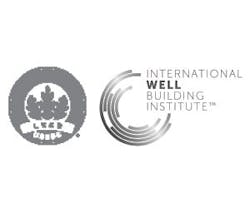How many certifications does your building have?
For most facilities, that answer is one. But in some cases, it makes sense to obtain additional building certifications. Two such programs, the WELL Building Standard and the LEED rating system, are made to complement each other.
“The biggest difference is that LEED overall is about sustainability, building materials, energy efficiency and the environment, whereas WELL is much more about human sustainability,” explains Irene Nigaglioni, Partner of PBK Architects. “WELL adds in the components of health and wellness, nourishment, fitness, comfort and mind, which LEED does not have. One builds on the other.”
Built to Work Together
Despite their different areas of focus, LEED and WELL share considerable overlap. For instance, LEED requires a ventilation rate that meets ASHRAE 62.1-2010, while WELL requires the stricter 2013 version. Meeting WELL’s ventilation benchmark would mean your project meets LEED’s as well. LEED includes permanent entryway systems in an optional Enhanced IAQ Strategies credit; WELL moves entryway walk-off systems to its own credit and makes it a prerequisite for all but interiors-only projects.
“WELL starts with some components that are similar to LEED. For air conditioning, you want energy-efficient buildings with the right amount of ventilation. Lighting should include introducing natural light into the space,” says Nigaglioni. “WELL takes it a step further and makes sure that it’s not just daylight, it’s the right level of daylight hitting the eye at the right time to complement human circadian rhythms.”
Keeping track of your efforts for one certification system will no doubt help you with the documentation required for the other, Nigaglioni adds.
“If you’re going for WELL, you’ve already built a platform. It has prerequisites to get to the silver level, and by the time you’ve done that, you’ve accomplished LEED,” Nigaglioni says. “You can line up both of them very easily.”
Know Your Certification Categories
WELL Building Standard
- Air
- Water
- Nourishment
- Light
- Fitness
- Comfort
- Mind
- Innovation
LEED Rating System
- Location and Transportation
- Sustainable Sites
- Water Efficiency
- Energy and Atmosphere
- Materials and Resources
- Indoor Environmental Quality
- Innovation
- Regional Priority (when applicable)
Best Practices for Dual Certification
Pursuing both certifications is certainly doable, but requires some extra planning to avoid duplicating steps or underperforming on credits where the requirements differ slightly. Nigaglioni advises project teams to consider a few points to get the most out of the certification experience:
Assess your facility beforehand. “Delos, the organization behind the WELL Standard, has a questionnaire to do about your space with questions like, ‘Do you think the air conditioning levels are good?’ and ‘Do you have access to natural light?’” says Nigaglioni. “It was incredibly helpful because it lets you look at your building and say, ‘I don’t have that much farther to go. I’ve already been concerned about energy efficiency and the right systems and materials – now I just have to take it to the next level.”
Get creative. Some building types have unique requirements. Educational facilities in particular are encouraged to educate students and visitors about the building’s green credentials. “It’s not just that the building is sustainable, it’s that students participate, are engaged and have the opportunity to affect their own environment,” Nigaglioni says. “We have flat screen TVs that have information on the energy efficiency and energy consumption of the building and how it changes depending on the time of year, time of day and weather. Students really understand how those factors impact their building and start making changes to make it better.”
Avoid pitfalls. The bulk of the points in both certifications are impacted by the major building systems, such as HVAC and lighting. Project teams sometimes have trouble checking off all of the boxes in these areas, so Nigaglioni recommends examining the requirements for each area ahead of time, determining where you might struggle and making a plan to maximize the building’s efficiency.
“The hardest parts are things like looking at your air conditioning system and figuring out whether it’s as efficient as it could be,” Nigaglioni says. “Maybe it’s time to change things out. MEP systems carry the biggest load of points. In other areas, like acoustics, it’s trendy to go toward open office spaces with touchdown areas, but acoustics is a huge component of WELL certification. Are you effective at creating quiet spaces where people can go if they need to do quiet work, or does sound transmit from one space to the other?”
Janelle Penny [email protected] is senior editor of BUILDINGS.
About the Author
Janelle Penny
Editor-in-Chief at BUILDINGS
Janelle Penny has been with BUILDINGS since 2010. She is a two-time FOLIO: Eddie award winner who aims to deliver practical, actionable content for building owners and facilities professionals.

